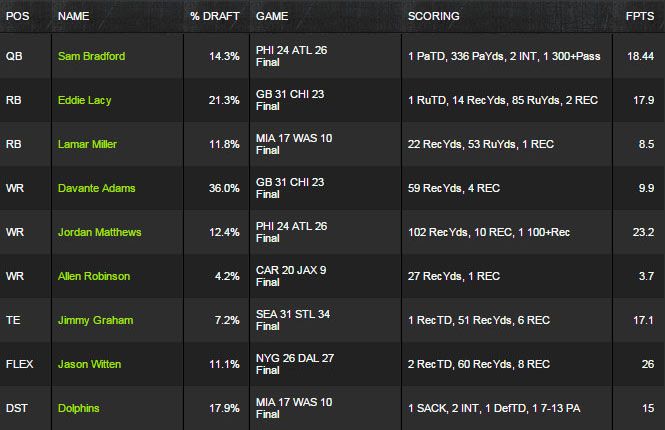WASHINGTON — If you’ve turned on a television in the past month, you probably don’t need me to tell you anything about one-day fantasy sports. It seems that nearly half the available advertising time available during any sporting event has been bought by one of the two leading companies, DraftKings or FanDuel.
Those of you who haven’t signed up for these sites yet — and there must still be a good number of you, considering how hard the marketing push has been — may be wondering if it’s worth it. As someone with a more than a decade of familiarity with fantasy sports and direct experience with the online poker boom a few years back, I decided to sign up to provide a guide to what one-day fantasy sports look like and help you decide if you want to partake.
What exactly are DraftKings and FanDuel?
I profiled the rise of one-day fantasy sports last year. And while both DraftKings and FanDuel have avoided the designation of a gambling website, which torpedoed the online poker industry in 2011, they operate under a very similar structure. A user buys into a structured game in which they have some control, then fate plays into the final outcome. A percentage of the players are paid out in a graduated structure, depending on their final score, determined by the site’s scoring system.
The companies have exploded in growth in the past couple years, thanks in large part to professional sports leagues buying in and partnering in an arena where they have previously steered clear. Over the past year, DraftKings competitor FanDuel has signed agreements with various leagues and teams, including here in Washington.
As Sports Business Journal reported earlier this week, the two companies are spending a half a billion dollars in advertising this year, and have become symbiotic with not only the professional leagues, but with media companies as well. Fox Sports has invested in DraftKings, with NBC Sports and Turner Sports both doing so in FanDuel.
While the industry is still evolving, FanDuel CEO Nigel Eccles told SBJ that there were only about 1.5 million registered users, so the frontier is still very much open.
My strategy
While I’m a bigger college football fan than I am of the NFL, I still have enough of an idea of the strengths and weaknesses of most NFL teams that I tried to employ a game-specific strategy in drafting my players. With a set amount of “salary money” to spend on players at fixed prices, the same for every other user, I looked to maximize value on certain players, while going with safer bets on others.
Atlanta’s pass defense was atrocious in 2014, so I took both Eagles quarterback Sam Bradford and top receiver Jordan Matthews for their Week 1 matchup against the Falcons. I took the always reliable Eddie Lacy, who had 99 combined yards and a touchdown. I took Jimmy Graham as my tight end, knowing the Seahawks would likely look to him in the red zone, and was rewarded with 51 receiving yards and a touchdown. I took the Dolphins defense against Washington and saw them allow just 10 points while pitching in a sack and two interceptions, as well as a punt return for a touchdown. And in perhaps my most inspired move, I took Jason Witten as a tight end in my flex spot against a soft Giants secondary, and he torched them for a pair of scores.
But I busted on Lamar Miller (77 yards), Davante Adams (59 yards) and Allen Robinson (27 yards). That meant I’d need a big night out of my pair of Eagles on Monday night to have a chance to win any cash.

It didn’t look good early, with Philly scoring just three first-half points. But the tide turned in the second half, opening a window.
In the fourth quarter, the Eagles drove down the field, deep into Atlanta territory. Sam Bradford completed a pass to Jordan Matthews, who turned the corner and headed for the goal line, pretty apparently sneaking the ball inside the pylon for a touchdown as he was pushed out of bounds. But the ball was marked out inside the one-yard line, and the Eagles didn’t challenge, punching it in on a run the very next play.
That had negligible impact on the game, but cost me both a passing and a receiving touchdown, costing me 10 points in a single play. That alone would have nearly been enough to get me into the money in both leagues. And while I’m thankful that wasn’t the sole difference, it highlights just how much of what happens is out of your control, even though a primary appeal of the daily fantasy format is the perceived increase in the user’s ability to dictate the outcome.
Had Jordan Matthews not let Bradford’s final throw slip through his hands for an interception, I would have been spared the docked points for the pick and awarded roughly a point and a half for the reception, picking up points from both players. Had the drive continued, there were more opportunities for points on every Bradford completion and Matthews catch.
But so could any number or other plays involving other players in other games. Ultimately, you’re still at the whim of all the same turns of fate as you’ve always been playing fantasy sports.
Payouts
Had I sneaked into the final tier of payouts, I would have won $25 on my $20 entry, and just $5 for my free entry. Of course, that’s well shy of the $2 million and $100,000 grand prizes, respectively, but still keeps over 22 percent (84,950 of 383,333) of the participants paid, and therefore potentially invested in continuing to play. That ratio was slightly higher (over 24 percent, 125,700 of 520,448) in the $10 Million Millionaire Maker game, which required a $20 investment.
In all, the emotional swings were similar to those I’ve felt playing other fantasy sports. If you’re into the adrenaline rush you get from a blackjack or poker table, you may well enjoy playing. The ability to be paid out in a single day and reset your lineup with new players no doubt has some additional appeal and semblance of added control. But in spite of its promotion as an “anyone can win money” proposition, the payout structures will look similar to those who have participated in online gambling before.






